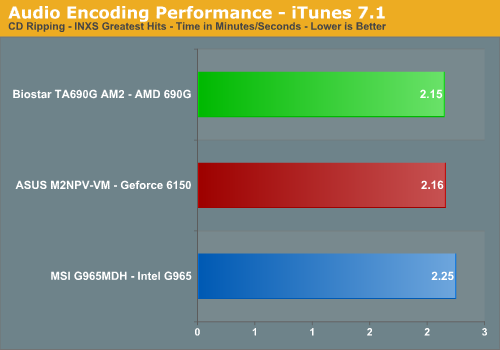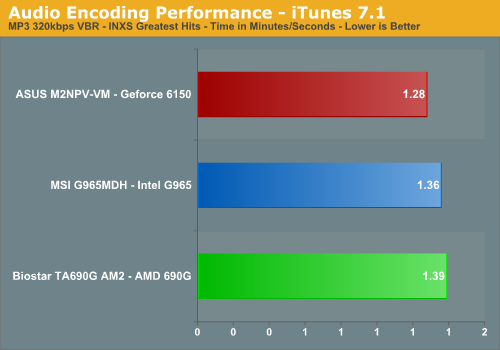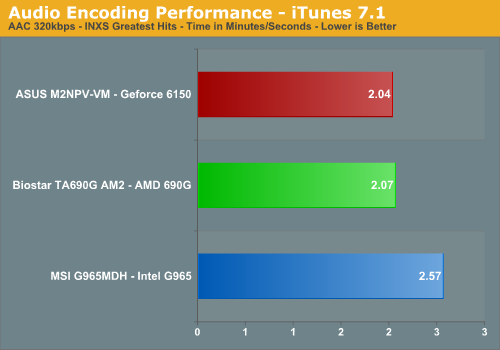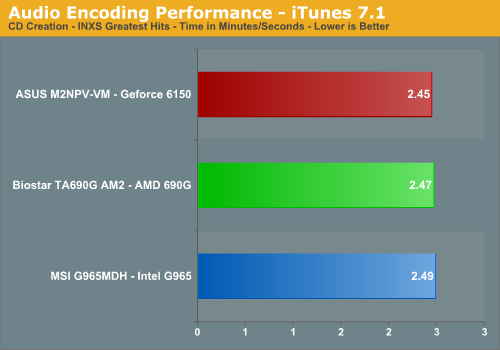Audio Encoding Performance
While the media encoding prowess of the Intel platform seemed to be lacking at times, we expect it to fair a little better on the audio side. Our audio test suite normally consists of Exact Audio Copy v095.b4 and LAME 3.98a3. We did run these tests with basically the same results but for our purposes today we will utilize iTunes 7.1 as it is one of the most utilized audio applications available due to the immense popularity of the iPod.
Our first task was to figure out what test CD to utilize. We needed one that contained a significant number of tracks and had over 600MB of data in order to properly stress our platforms. After rummaging around the lab and discounting the Burl Ives Greatest Christmas Hits album, we happened upon a CD that would work for our purposes as it was not working for anyone else, INXS Greatest Hits. This one time '80s glory masterpiece contains 16 tracks totaling 606MB of songs that was instantly whisked into our anxiously awaiting optical drive.
Our first test consists of utilizing iTunes to rip our INXS CD to WAV format on our hard drive. Even though CPU speed and optical drive selection have a great impact on these test results we are using the same optical drive between platforms for each test.

Our two AM2 platforms score slightly ahead of our Intel setup but the margin is minimal. This test was very consistent with each result never varying more than one second from the base score. Unlike the Nero Recode 2 DVD burning test, in this case our AMD systems did not suffer from drive issues.
Our next two tests have us utilizing iTunes to convert our WAV files into ACC or MP3 compatible formats. We utilize the 320kbps setting for both tests with the MP3 test also utilizing the variable bit rate option.


We usually see iTunes favoring the AM2 platforms in most test results. The results are no different here with both AM2 systems completing the ACC conversion about 50 seconds before the Intel system. In our MP3 conversion, the Intel system places second but the general differences are minimal. We attribute the 6150 performance to better storage controller and CPU throughput although standard memory bandwidth is lower than the other two boards.
Our final test has us creating a legal use copy CD from the base WAV files we collected when ripping the INXS Greatest Hits CD. Not that the world needs anymore of these CDs but it makes for a good closing test. We promise all CDs are destroyed after testing (much to the pleasure of our ears and those at the RIAA).

Once again our test results are extremely close with the optical drive playing a leading role in ensuring our results are fairly close. The minor differences are all attributable to the better disk performance of the NIVIDA 6150/430 combination in this case. We noticed each time that the disk access stopped about two to three seconds quicker with the 6150 platform. This is opposite of our Video Encoding results where each of our AM2 platforms could not keep the optical drive fed properly over the course of a burn session.
While the media encoding prowess of the Intel platform seemed to be lacking at times, we expect it to fair a little better on the audio side. Our audio test suite normally consists of Exact Audio Copy v095.b4 and LAME 3.98a3. We did run these tests with basically the same results but for our purposes today we will utilize iTunes 7.1 as it is one of the most utilized audio applications available due to the immense popularity of the iPod.
Our first task was to figure out what test CD to utilize. We needed one that contained a significant number of tracks and had over 600MB of data in order to properly stress our platforms. After rummaging around the lab and discounting the Burl Ives Greatest Christmas Hits album, we happened upon a CD that would work for our purposes as it was not working for anyone else, INXS Greatest Hits. This one time '80s glory masterpiece contains 16 tracks totaling 606MB of songs that was instantly whisked into our anxiously awaiting optical drive.
Our first test consists of utilizing iTunes to rip our INXS CD to WAV format on our hard drive. Even though CPU speed and optical drive selection have a great impact on these test results we are using the same optical drive between platforms for each test.

Our two AM2 platforms score slightly ahead of our Intel setup but the margin is minimal. This test was very consistent with each result never varying more than one second from the base score. Unlike the Nero Recode 2 DVD burning test, in this case our AMD systems did not suffer from drive issues.
Our next two tests have us utilizing iTunes to convert our WAV files into ACC or MP3 compatible formats. We utilize the 320kbps setting for both tests with the MP3 test also utilizing the variable bit rate option.


We usually see iTunes favoring the AM2 platforms in most test results. The results are no different here with both AM2 systems completing the ACC conversion about 50 seconds before the Intel system. In our MP3 conversion, the Intel system places second but the general differences are minimal. We attribute the 6150 performance to better storage controller and CPU throughput although standard memory bandwidth is lower than the other two boards.
Our final test has us creating a legal use copy CD from the base WAV files we collected when ripping the INXS Greatest Hits CD. Not that the world needs anymore of these CDs but it makes for a good closing test. We promise all CDs are destroyed after testing (much to the pleasure of our ears and those at the RIAA).

Once again our test results are extremely close with the optical drive playing a leading role in ensuring our results are fairly close. The minor differences are all attributable to the better disk performance of the NIVIDA 6150/430 combination in this case. We noticed each time that the disk access stopped about two to three seconds quicker with the 6150 platform. This is opposite of our Video Encoding results where each of our AM2 platforms could not keep the optical drive fed properly over the course of a burn session.










70 Comments
View All Comments
JarredWalton - Tuesday, March 6, 2007 - link
What's worse is that the G965 scores almost twice as high in 3DMark06... and then falls flat on its face in actual gaming tests. (Well, most of them anyway.)IntelUser2000 - Wednesday, March 14, 2007 - link
I think it might be combination of Vista too. Half Life 2 can score ~20 fps with G965 at the same settings AT tested at, when using Windows XP. I would also like to see how it performs it in XP. It seems G965 suffers more from Vista then other IGP.
chucky2 - Tuesday, March 6, 2007 - link
I think it would be good insurance, given how amazingly late 690G is, to please confirm with AMD that 690G motherboards will definitly support the AM2+ CPU's this late summer/fall.And before people remind me that this is already fact, we have not to my knowledge see AMD themselves confirm this...which for something so seemingly simple to confirm, is getting distrubingly telling.
When AnandTech updates their article and says that they've gone back and confirmed with AMD that all 690G boards being release with support AM2+, or AMD themselves says it, then we'll know for sure. Until then, it's rumor...
Chuck
JarredWalton - Tuesday, March 6, 2007 - link
AMD has not officially stated whether the Agena/Kuma will be drop-in compatible with current AM2 chipsets (or even the AM2 socket). We'd certainly love to know, but we're still waiting along with everyone else.chucky2 - Tuesday, March 6, 2007 - link
Do they have any idea, and have you specifically put the question to them? I'm sure you have contacts at AMD......because from what I can tell, if a discrete graphics card is used, this chipset is looking like when Dr. Evil says, 1 million dollars! ...and then everyone is like, Uh, big deal...
...this thing should have released in Sept. of last year, and then become the defacto AMD chipset, not be released now - as you point out - with MCP68 right around the corner and the G35 coming also.
This chipset really looks to me like a could have been. Good work ATI (and then AMD)!!!
Chuck
Gary Key - Tuesday, March 6, 2007 - link
We asked the question Chuck, have not received an official answer yet. While backwards compatibility has always been discussed as possible by AMD, we are still not convinced with any of the current motherboards. One only has to look at the Conroe launch last year and realize that while the chipsets were compatible, the motherboards were not without an update. We just recently saw this again with Kentsfield. We wish this chipset would have been released last fall also. ;)chucky2 - Tuesday, March 6, 2007 - link
Thanks Guys, that's about all I can ask for.I guess now I've got to really sit down and decide what's the best course of action for my godson and also cousins builds. Their both going to be budget builds, but I don't want to build them an AM2 system and basically have it be End Of Lifed in 3-4 months.
You'd think if AMD wanted to stop the hemmoraging their seeing on the enthusiast side, they'd make a statement about AM2+ compatibility now, rather than wait and just keep loosing more and more. Not that a lot won't go over to the Intel side, but still, tell me 690G and say MCP68 will be the only AM2 chipsets that can take AM2+ CPU's, and now at least I've got a comfortable long term upgrade path.
Leave me in doubt, I mine as well get a 1333FSB Intel board and go to the dark side...
Looking forward to that mATX review...you think it'll be out this time next week, or towards Friday?
Chuck
JarredWalton - Tuesday, March 6, 2007 - link
Honestly, the fact that AMD hasn't come out and said the next gen CPUs will work in AM2 speaks volumes in my book. Perhaps they are just trying to keep things quiet so that a bunch of people won't complain that their particular board won't run the new processors (some 939 boards wouldn't work with X2, after all, and there were some complaints saying AMD "guaranteed backwards compatibility). Hopefully that's all it is, but I am seriously concerned that Kuma and Agena will not work in the vast majority of AM2 boards - that's assuming they'll work in any at all.If AMD doesn't support older boards with the new processors, they are going to need some really impressive performance to keep people from raising Cain. As it stands, if a reasonably fast X2 5200+ or so isn't good enough for your long-term needs, I certainly wouldn't purchase a new AM2 system with the hope of an upgrade until the truth comes out.
Final thought: The Quad FX platform has clearly been stated as being forwards compatible with native quad core Barcelona chips. If AMD is willing to make that commitment, why not make a similar commitment with AM2 and Agena/Kuma?
dmce - Tuesday, March 6, 2007 - link
Are we going to see some details regarding HD (1080P) playback and whether it can do it comfortable or not. I appreciate you made a small comment about it, but this was lifted from the original look at the 690G chipset a few days ago so no real update in this review. Im just puzzled no sites are taking a closer look at this considering its surely one of, if not the whole point of HDMI being there?Im not interested at all in using this for games, i want a 1080p capable machine.
PokerGuy - Wednesday, March 7, 2007 - link
I'm considering a board based on the 690G for my new HTPC, but now I see it won't be able to output 1080P? Yipes... even the lowly 6150 can output at 1080P, correct?Games are not important with regard to this board, but if it can't output at 1080p, what use would it be in a HTPC??
Also, any ETA on when the mATX roundup will be released?